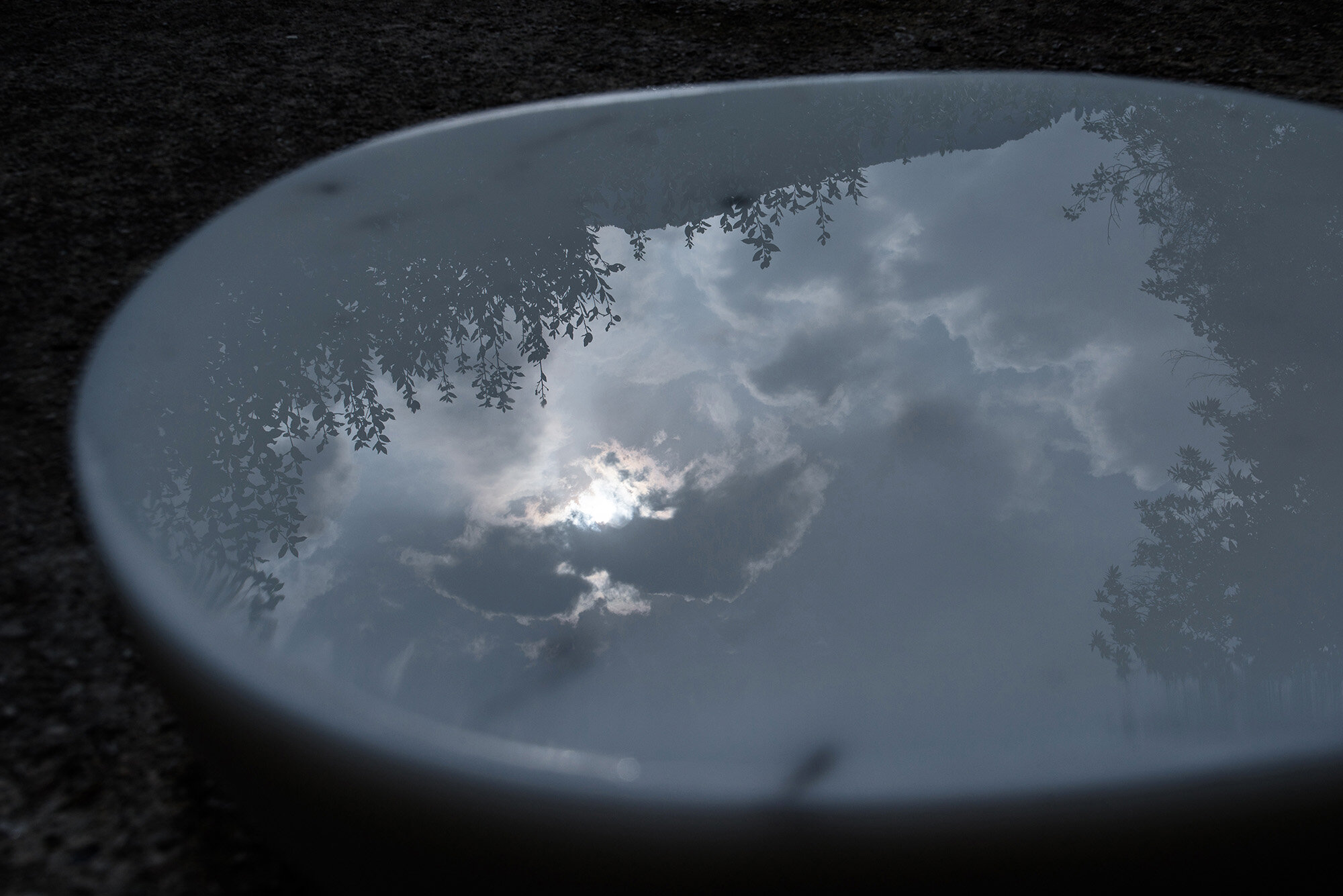REFLECTING STONE
petrartedizioni atelier, Italy
Curated by Giovanni Bovecchi for the exhibition Reflections
Supported by the Canada Council for the Arts
Statuario marble (salvaged), natural spring water collected in Tuscany
Marmo statuario (scartata), acqua di sorgente naturale di Toscana
2019
“The lithic is oceanic…Mountains surge and fall, their epochal undulations no less animated than the swell and crash of seas…we are saturated in the lithic.”
Reflecting Stone (Pietra riflettente) combines the elements of stone and water into a contemplative sculpture about the geological heritage of Tuscany. The work considers the primordial elemental relationship that bound together, in a single crystallized embrace, the stratigraphic layers of land and sea, forming Italy’s renowned Carrara marble.
The Carrara marble of Tuscany was created through a significant geodynamic event during formation of the Apuan Alps. Fossils in the region reveal a geomorphological history of a land once beneath water due to the proximity of the alps to the Ligurian Sea. Across the mists of geologic time, layers upon layers of prehistoric marine animals, the calcareous shells of molluscs, coral and crustaceans, found their final resting place in a bed at the bottom of an ancient shallow sea, ultimately forming a platform of sedimentary limestone as long as 300 million years ago. Immense pressure and heat from tectonic processes recrystallized the organic rock, creating a magnificent marble, a metamorphic transformation estimated to have occurred over a period of 20 million years (1).
The marble sculpture was completed with water collected from a natural spring in Valdicastello Carducci, a village in the lower foothills of the Apuan Alps. The drinkable water source originates from rainwater and river processes that collect in underground pools deep in the mountains – instilling the water with a unique terroir. The water was poured onto the slight concave plane of the marble, revealing a reflective surface that mirrored the sky above. Stone and water merged like land and sea. In this ephemeral reflective pool, Abel observed atmospheric phenomena – sun, moon and clouds – as did ancient Inca astronomers who created stone “water mirrors” to observe and interpret the celestial cycles that signal the passage of time.
In Jeffrey Jerome Cohen’s book Stone: An Ecology of the Inhuman, he writes, “Stone is never a lone element but a partner with water, fire, air, organic life. In stone a sense of place joins a sense of planet […] Stone emphasizes the cosmos in cosmopolitan, the universe of inhuman forces and materialities that stretches to the distant arms of the galaxy” (2). The relationship between the stone and water of Reflecting Stone suggests resumption of a timeless symbiosis, an expansion of spatial and temporal perceptions.
The Tuscan sky reflections were documented and translated into a series of translucent black and white prints on glass, titled Stone Reflections (Riflessi di pietra).
STONE REFLECTIONS (Riflessi di pietra)
Photographic prints on glass / Stampe fotografiche su vetro, 35.5 x 46 cm / 14 x 18 in
Karen Miranda Abel travelled to Pietrasanta, Tuscany, in the summer of 2019 to encounter the essence of Carrara marmo in its place of origin, where artists and stone masons have cultivated a deep understanding of the stone’s particular character for more than two millennia. Located near Carrara, Pietrasanta is internationally known as a city of artists, having deep roots in Italy’s legacy of art and a colony of international contemporary artists. Pietrasanta famously attracted master sculptor Michelangelo Buonarroti, who came to work with the region’s exquisite marble more than 500 years ago. Twentieth century artists Louise Bourgeois, Isamu Noguchi, Barbara Hepworth, and Henry Moore were similarly drawn to Pietrasanta to work with marble.
Reflecting Stone was carved from a block of reclaimed statuario (statuary) marble at the studio of artist Kyle Ann Smith in Pietrasanta. Previously worked by another artist in the mid-nineties, the abandoned marble block had since remained outside, where it aged from the elements. After more than two decades, the marble developed a dark natural patina which was carefully removed by Abel, bringing to light the almost pure white marble beneath.
Intro. Cohen, Jeffrey Jerome. Stone: An Ecology of the Inhuman. University of Minnesota Press, 2015, p. 34.
1. Kligfield, R. et al. "Dating of deformation phases using K-Ar and 40Ar/39Ar techniques: results from the Northern Apennines." Journal of Structural Geology, vol. 8 (7), 1986, pp. 781-798.
2. Cohen, Jeffrey Jerome. Stone: An Ecology of the Inhuman. University of Minnesota Press, 2015, p. 38.
The Canada Council for the Arts is gratefully acknowledged for funding this project










